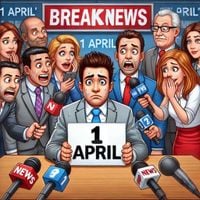As April Fool's Day approaches, organizations worldwide are gearing up for the annual tradition of pranks and jokes, which can either elevate a brand's visibility or lead to significant reputational damage. The key to success lies in executing these stunts with transparency and humor, avoiding the pitfalls that have ensnared others in the past.
One notable example of a poorly executed prank involved the municipality of Vlaardingen, which announced that Café Mes would need to change its name due to a new anti-weapon policy. Initially, the media took the bait, but a spokesperson later denied it was a joke. The truth emerged only after publication, resulting in critical questions from parliament and a public apology from the mayor. This incident highlights the fine line between humor and deception, illustrating how quickly a harmless joke can spiral into a public relations crisis.
Similarly, the 'moon panel stunt' by Hoppenbrouwers, which claimed to offer solar panels that could generate energy from moonlight, was another case of a joke gone awry. While it was intended as a prank, the media picked it up as a serious claim, leading to confusion and disappointment. In contrast, Churandy Martina's 'delivery service,' where groceries would be delivered by runners, also started as a joke. However, the PR firm involved maintained the ruse until journalists caught on, which ultimately undermined the joke's intent and damaged trust.
On a brighter note, some organizations have mastered the art of the April Fool's joke. Tech giant Google has a history of crafting clever and transparent pranks, such as Google Tulip, a fictional tool that claimed to enable users to converse with tulips. This prank was clearly presented as a joke, wrapped in a professional video and website, resulting in widespread media attention and positive engagement without any reputational fallout.
Another successful prank came from HEMA, which announced a 'sausage drive-thru' via Instagram. The concept was amusing enough to raise eyebrows but not so outrageous that it led to misunderstandings. Both companies ensured that the audience quickly recognized these as jokes, preserving their brand integrity.
As organizations prepare for April Fool's Day, they should consider the following guidelines to create media-proof pranks that can go viral without causing harm:
- Be Honest: Always maintain transparency with the media. If a journalist inquires about the prank, respond honestly or skillfully deflect with a light-hearted comment about the timing of April Fool's Day.
- Plan for Leaks: Ensure that the joke can still work if leaked prior to the intended reveal. If secrecy is crucial for the prank's success, reassess whether it's the right approach.
- Check the Sentiment: Be cautious with jokes about sensitive topics, as they can lead to backlash and reputational damage. Consider potential reactions carefully.
- Prepare for Media Attention: Anticipate questions from journalists and strategize how to remain transparent without giving away the joke too early.
A well-executed April Fool's prank can yield significant benefits, drawing attention and generating goodwill, but it is essential to safeguard the trust of both the audience and the media. After all, if a prank backfires, the laughter may quickly fade.
In a related discussion on workplace humor, comedian Maarten Vissers emphasizes the importance of humor as a gauge for a safe working environment. According to Vissers, who trains companies through his agency Humor Loont, humor can foster connections among colleagues. However, he warns that inappropriate jokes, especially on April 1st, can lead to discomfort and reinforce a culture of fear.
"If there’s little laughter in the office, there’s probably a culture of fear," Vissers states. He points out that humor often revolves around human shortcomings and that jokes frequently come at someone else's expense. This dynamic can create a challenging atmosphere if not handled thoughtfully.
As organizations navigate the complexities of humor in the workplace, they must strike a balance between light-heartedness and sensitivity. The ability to laugh together can enhance camaraderie, but the wrong joke can lead to misunderstandings and conflict.
Ultimately, whether on April Fool's Day or any other day, the goal should be to cultivate an environment where humor is welcomed, but respect and understanding remain paramount. As Vissers suggests, the best humor connects people rather than divides them, allowing for a more engaged and cohesive workplace.





